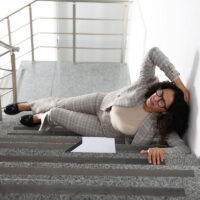Stairway Falls in Office Buildings or Commercial Spaces

Stairways are a common feature in office buildings, shopping centers, and other commercial spaces across New York City. Because of their frequent use, they are also a common location for accidents. A fall on stairs can result in serious injuries, from broken bones to traumatic brain injuries, and sometimes permanent disability. While people may assume such accidents are just a matter of clumsiness, the law recognizes that property owners and managers have a duty to keep stairways safe. When negligence is involved, injured victims may be entitled to compensation through a personal injury claim. Learn more below, and contact Leandros A. Vrionedes, P.C., to speak with a skilled and experienced New York stairway accident attorney. We represent injury victims throughout New York City in Brooklyn, Bronx, Queens, Manhattan, as well as Nassau and Westchester counties.
The Duty to Maintain Safe Stairways in Office Buildings
Under New York premises liability law, property owners and tenants in control of commercial spaces have a legal duty to maintain stairways in a reasonably safe condition. This duty includes more than just occasional cleaning. Owners and managers must:
- Repair broken or uneven steps
- Install and maintain secure handrails
- Provide adequate lighting
- Remove debris or obstacles from stairways
- Address slippery conditions from water, ice, or cleaning products
Failure to take these steps can create dangerous conditions that put employees, customers, and visitors at risk.
Common Causes of Stairway Falls in NYC Commercial Properties
Stairway accidents in office buildings and commercial spaces often occur because of hazards that could and should have been prevented. Some of the most frequent causes include:
- Poor lighting – Dimly lit stairwells make it difficult to see steps clearly, increasing the risk of missteps.
- Broken or missing handrails – A handrail can be the difference between regaining balance and suffering a hard fall.
- Uneven or broken steps – Cracked, warped, or uneven stair treads create tripping hazards.
- Worn or loose carpeting – Frayed carpeting can catch on shoes or cause slips.
- Slippery surfaces – Spilled liquids, tracked-in snow, or improper cleaning can make stairs slick.
- Clutter or debris – Boxes, cords, or trash left on stairways can obstruct safe passage.
Each of these conditions may indicate negligence on the part of the property owner, manager, or maintenance staff.
The Role of Building Codes and Regulations
In New York, building codes set minimum safety standards for stairways. For example, stairways must have a uniform rise and run, adequate lighting, and properly placed handrails. Commercial properties that fail to comply with these requirements may be considered negligent per se, meaning the violation itself is evidence of negligence.
Similarly, the New York City Housing Maintenance Code and local regulations require property owners to maintain their premises in a safe condition. For office buildings and commercial properties, this duty is taken seriously because high traffic volumes mean more opportunities for accidents.
Proving Negligence in a New York Stairway Fall Case
To succeed in a personal injury case after a stairway fall, the injured person must prove that the property owner or manager was negligent. This typically involves showing that:
- A dangerous condition existed on the stairway.
- The owner or responsible party knew, or should have known, about the hazard.
- The hazard was not repaired or adequately addressed within a reasonable timeframe.
- The condition caused the fall and resulting injuries.
Constructive notice—the idea that the hazard was present long enough that a reasonable inspection would have uncovered it—is often a key issue in these cases. Evidence such as maintenance logs, witness testimony, photographs, and surveillance footage can be critical.
Comparative Fault and Shared Responsibility
In some cases, property owners argue that the injured person was partly at fault. For example, they may claim the victim was distracted, wearing inappropriate footwear, or ignored warning signs. Under New York’s comparative fault rule, even if a victim is partly responsible, they can still recover damages, but the amount is reduced by their percentage of fault.
This makes it all the more important to work with an attorney who can counter these arguments and demonstrate how the property owner’s negligence was the primary or sole cause of the accident.
The Impact of Stairway Falls
Stairway falls can cause injuries that go far beyond minor bruises. Victims often suffer:
- Fractures in the wrist, arm, ankle, or hip
- Head injuries and concussions
- Spinal cord or back injuries
- Torn ligaments or soft tissue damage
These injuries can require hospitalization, surgery, physical therapy, and extended time off work. In severe cases, victims may be left with long-term disabilities that affect both quality of life and earning capacity.
Why Legal Representation Matters
Commercial property owners and their insurance companies often fight stairway fall claims aggressively. They may deny negligence, argue the victim caused their own injuries, or offer low settlements that do not reflect the true cost of medical bills and lost income.
An experienced personal injury lawyer can investigate the accident, gather evidence, work with experts when necessary, and build a strong case for compensation. This includes damages for medical expenses, lost wages, pain and suffering, and long-term care needs.
Call New York Stairway Accident Lawyer Leandros A. Vrionedes Today
At Leandros A. Vrionedes, P.C., we have extensive experience handling stairway fall cases in office buildings and commercial spaces across New York City. We understand the building codes, the legal standards for negligence, and the tactics property owners use to avoid responsibility.
If you or a loved one has been injured in a stairway fall in New York, don’t let the property owner or their insurer shift the blame. Contact our office today for a free consultation. We’ll review your case, explain your legal options, and fight to secure the compensation you deserve.
